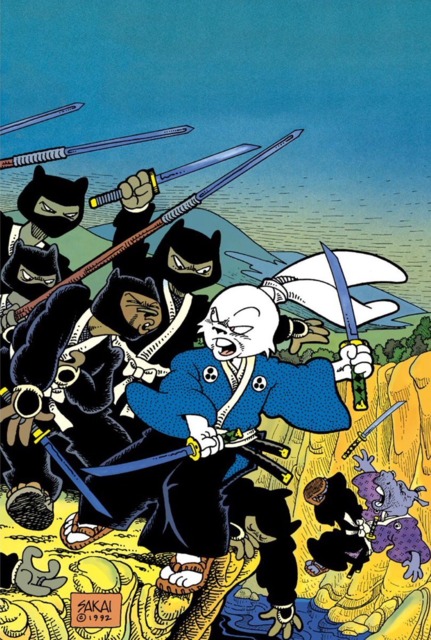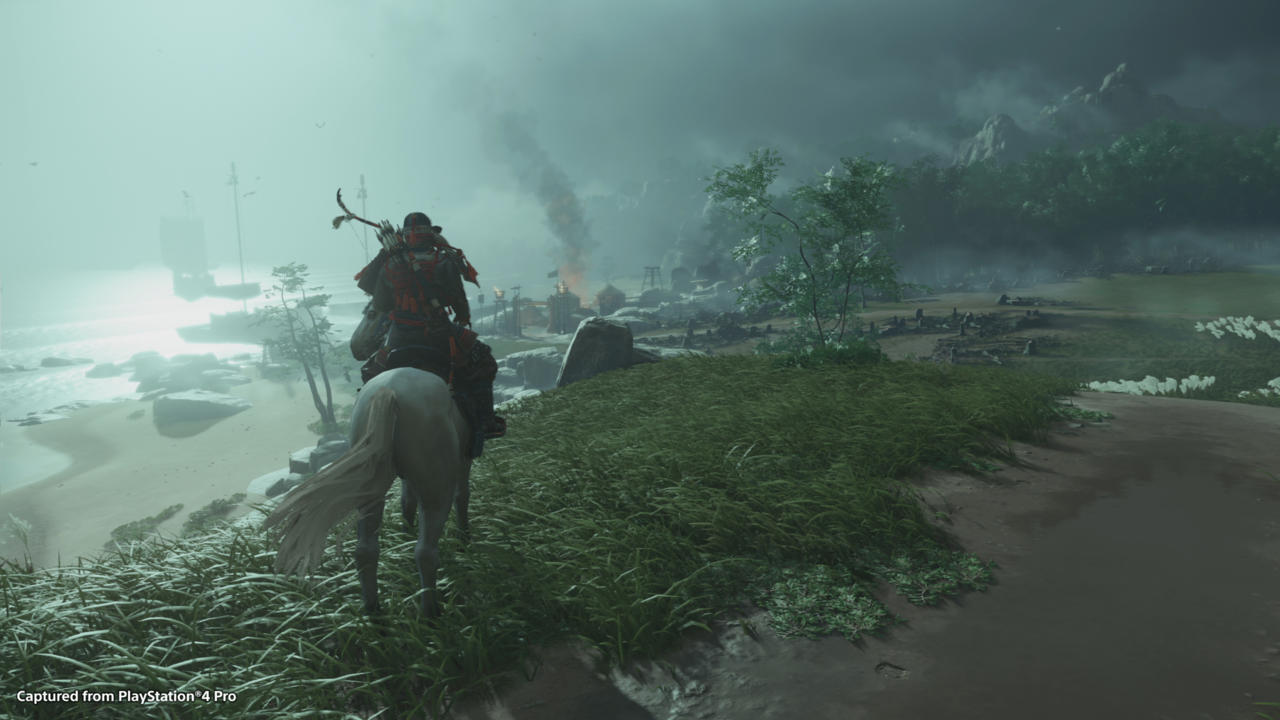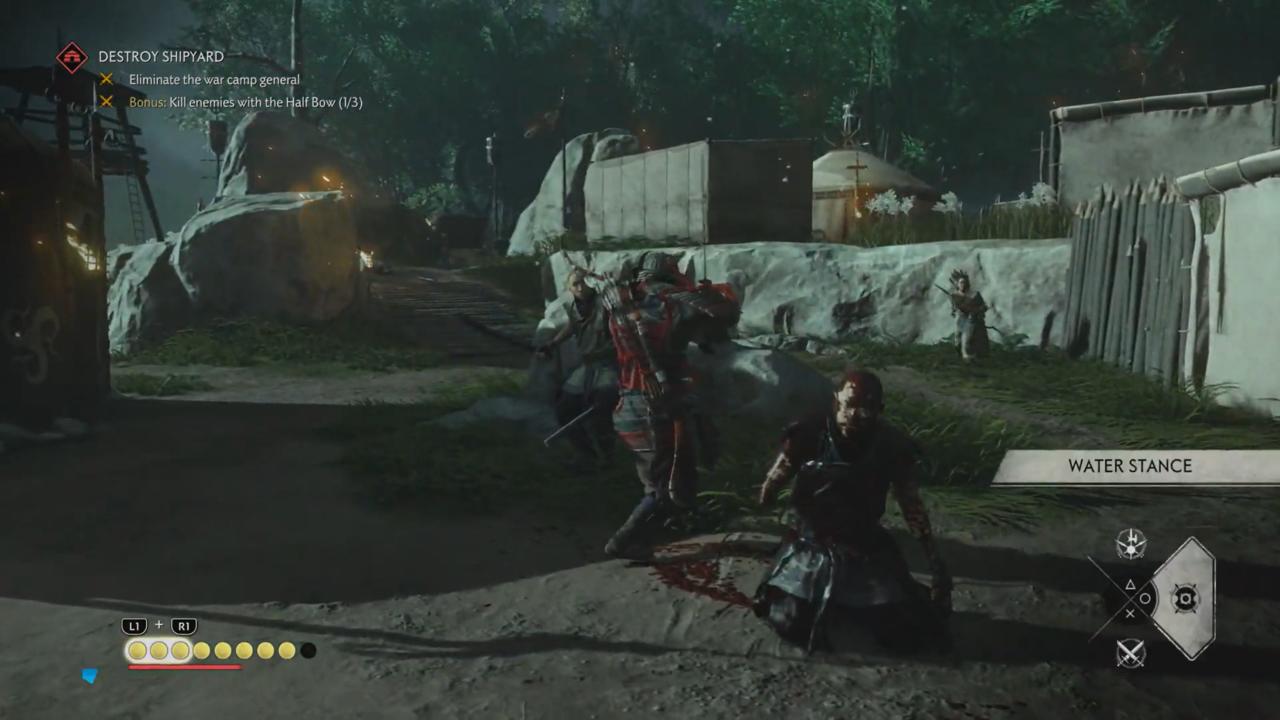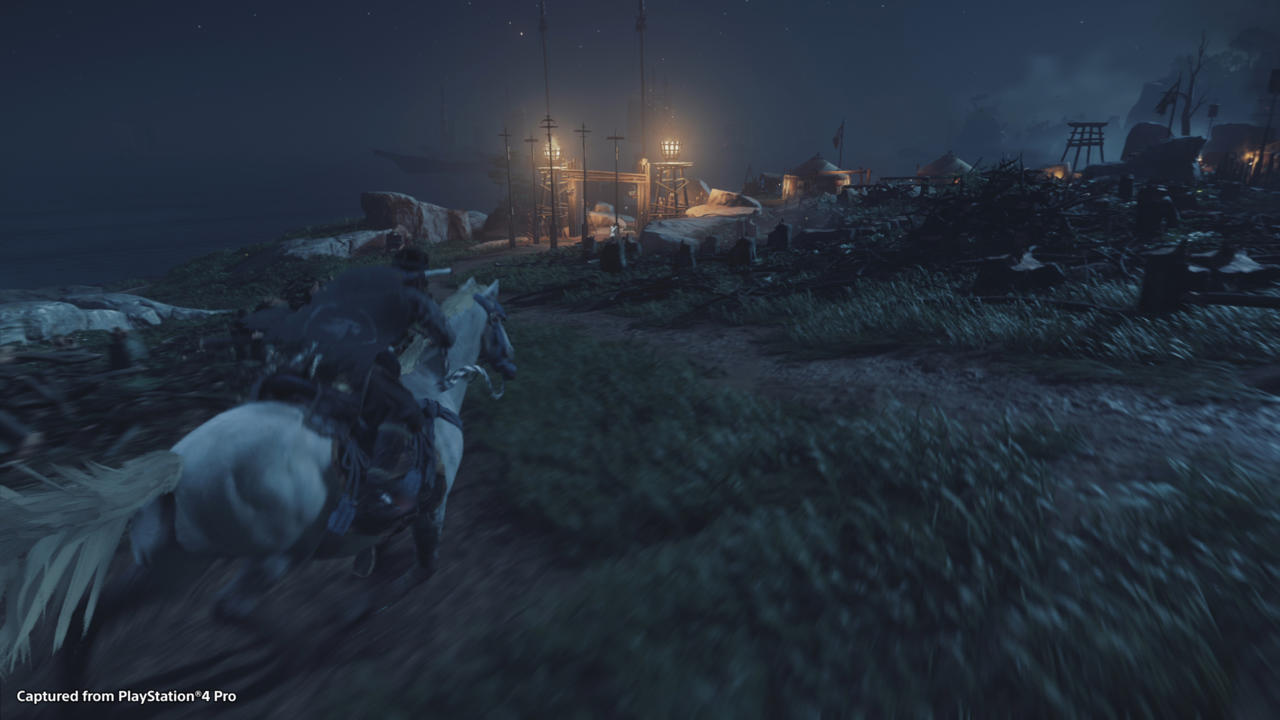Sucker Punch's Ghost of Tsushima has been a long time coming. The game was officially revealed at Paris Games Week in 2017, but development on the project began shortly after the release of Infamous: First Light in 2014. The studio has been working on the game for close to six years, a development cycle that almost encapsulates the PlayStation 4's entire lifespan. Whether by design or by fortuity, Sucker Punch showed off what Sony's console could do in its infancy and now is poised to show how far it has come in its maturation. Ghost of Tsushima is one of the last major first-party games announced for the PS4, releasing one month after The Last of Us Part 2.
The game they've made to show off that growth is, in the team's own words, more ambitious than anything Sucker Punch has done before. Ghost of Tsushima is an open-world, stealth action game that draws its inspiration from classical samurai cinema, but also looks to tell a grounded, poignant story about struggling against oppressors and the extreme lengths a person will go to in order to preserve their culture and community.
Ahead of Ghost of Tsushima's release on July 17, we talked to creative director Nate Fox about the studio's journey, the inspirations behind the game, and the intricacies of its gameplay. Be sure to also check out our Ghost of Tsushima review.
It's been around six years now since Ghost of Tushima was announced, what is it like to be actually able to talk about the game finally?
Another Crab's Treasure Is A Soulslike 3D Platformer | GameSpot Review Stellar Blade Review Nintendo 64 – April 2024 Game Updates – Nintendo Switch Online Super Monkey Ball Banana Rumble - Official Multiplayer Features Trailer PUBG | Erangel Classic Returns Gori: Cuddly Carnage | Meow Launch Date Announcement Trailer Genshin Impact - "Arlecchino: Afterglow of Calamity" | Collected Miscellany Marvel Rivals - Official Loki Character Reveal Trailer | The King of Yggsgard Fortnite Festival - Official Billie Eilish Cinematic Season 3 Trailer Remnant 2 - The Forgotten Kingdom | DLC Launch Trailer Stellar Blade - Official "The Journey: Part 2" Behind The Scenes Trailer | PS5 Games Dead by Daylight | Tome 19: Splendor | Reveal Trailer
Please enter your date of birth to view this video
By clicking 'enter', you agree to GameSpot's
Terms of Use and Privacy Policy
It's fantastic. You make the game that you always wished somebody would make and you get to play it every day at work and you get more excited about the features. Then to be able to show a big chunk of gameplay to the world and then have people like it, it feels magnificent.
You mentioned there that it's the game that you wanted to make. You can see the DNA of Sucker Punch in Tsushima, but the historical focus is very different for the studio. How did you reach that point?
Way back when working on Sly Cooper, I was writing the dialogue for the game. [Sly Cooper] features anthropomorphized animals. It reminded me of a comic that I had read years before that I started reading again aggressively to get a feel for how characters can speak to each other with a lot of respect. It's this comic called Usagi Yojimbo. You ever read it?
Oh yes, it's excellent.

Right. So I'm reading Usagi Yojimbo and it's this big collection of stories about a samurai who wanders feudal Japan, walks into town, and uses his wits and the edge of his sword to solve problems. I thought, "Man, this would be a dynamite thing."
Move forward in time. We make the InFamous series. We get done and we're looking for something else to do, and the whole time I've been thinking, "How come nobody's made a wandering samurai game?" And now we're looking for something to do, so it's something that I personally got very excited about because it was the game that I had been waiting for for a long time to see in the world.
That's really cool. I never expected Usagi Yojimbo to be an influence but I am glad it is.
Sucker Punch is known for parkour and traversal, but this has a whole new set of gameplay disciplines. What did you identify as needing to really get right to realize that wandering samurai vision?
Well, when most people get asked what a samurai means to them, the ... As a matter of fact, I asked this question of all my colleagues, and the winner was the movie Seven Samurai, which I'm a big fan. Have you ever seen it?
Yeah, I love it.
It's a masterpiece. There are all these conventions of classic samurai movies that we thought, "This is it. If we can take these conventions, the swordplay conventions, the way nature is shown, the way that respect is traded between samurai and the peasants and other swordsmen, if we can capture that and put it into this game we will have something that is really special." So we became students of these movies and turned some cinematic convention into interactivity.
How do you balance what a samurai was in real life versus what people may have seen from media--the fantasy and expectation that creates?
A lot of the samurai identity comes very much from samurai film. However, we wanted to do right by providing a feeling of authenticity, and that meant admitting that a bunch of American developers did not know what they were talking about, and drawing in experts from many different fields to teach us what it was like at that time. We have experts on religion, on costume, on motion. We brought them in early and often to review the game.

It helps, of course, that we're part of Sony. Early on, Japan Studios actually took us on a tour of Tsushima Island for research. They even went so far as to help us with audio recording so that the game sounds right. It's those partnerships that bring the feeling of the game so that you are wandering through feudal Japan.
You talked about how important exploration is. How are you striking the balance between making sure people are finding things naturally in the way that you want, but aren't wandering around aimlessly? How do you push people to the right point without them being able to feel the hand pushing them there?
I think the best example of that is the guiding wind that we showed in the State of Play demo. You might choose, as a player, by going to the map and saying, "I want to go right here," and you go back into the world and there's no UI. There's just this in world wind that points you in a direction. It doesn't tell you how to get there, it just says, "It's over here."
Another Crab's Treasure Is A Soulslike 3D Platformer | GameSpot Review Stellar Blade Review Nintendo 64 – April 2024 Game Updates – Nintendo Switch Online Super Monkey Ball Banana Rumble - Official Multiplayer Features Trailer PUBG | Erangel Classic Returns Gori: Cuddly Carnage | Meow Launch Date Announcement Trailer Genshin Impact - "Arlecchino: Afterglow of Calamity" | Collected Miscellany Marvel Rivals - Official Loki Character Reveal Trailer | The King of Yggsgard Fortnite Festival - Official Billie Eilish Cinematic Season 3 Trailer Remnant 2 - The Forgotten Kingdom | DLC Launch Trailer Stellar Blade - Official "The Journey: Part 2" Behind The Scenes Trailer | PS5 Games Dead by Daylight | Tome 19: Splendor | Reveal Trailer
Please enter your date of birth to view this video
By clicking 'enter', you agree to GameSpot's
Terms of Use and Privacy Policy
As you're traveling through the landscape, you're going to get distracted. Maybe you see a bunch of Mongols raiding a farm, or in the State of Play there was a bear that was mauling someone. These are things you could just choose to engage in as you explore Tsushima. When you know you chose to set the wind to go right here, that doesn't mean you have to do it. In fact, I would hope that you don't. I would hope that you find yourself looking at a hill and seeing some fire and thinking, "Well, somebody lit that fire. I don't know if they're friend or foe but somebody's up there." And when you go up there, you're rewarded with content or a secret that makes your curiosity justified.
How do these moments materialize as gameplay? Does it always inevitably end in some sort of combat scenario or is there gameplay variety in those moments?
Certainly there is a fair amount of combat in the game, but there's more to life than just sword fighting [in Ghost of Tshushima]. There's a lot of people in need and a lot of ways in which you can serve them. This game, while it tracks Jin's trajectory from this samurai to giving up his identity to become the ghost, there are characters you'll meet along the way that, if you decide to, you can get invested in their stories and in helping them out. It's part of discovery. The game is an anthology of stories that get you to say, "What's over that hill? There's probably somebody there that could use help." And it's not always fighting at all.
The goal of the game is to get the Mongols out of Tsushima to save the people of your home. And that takes a lot of different forms, like the shipyard in the State of Play demo, or helping somebody recover a loved one that's been taken by the Mongols, or finding something that's just been lost while fleeing, looking for food, that kind of thing. This is a wartime epic where you get to know a lot of people who are struggling to survive inside of a very harsh landscape.
In the combat you showed Jin doing these almost instantaneous sword slashes. How do I play that? Is it a Batman-style counter system?

The game definitely features counters. If you have the patience and the skill to read what the enemy's going to do and then time it right, you can unleash a really devastating counterattack. That's not the only way you can play. You can also force the attack. You can go after them. It's not just a waiting game. It's a very skill-based experience.
One of the things that we strive for really, really diligently is to keep swords lethal. To feel like those samurai movie battles, enemies have to die with a few strokes of a katana, otherwise it's not a katana, it's a Nerf tube. That means that when they hit you with swords, you also are going to die in a few strikes. It's very challenging.
Does that mean the customization that you showed off isn't as focused on the sword itself? It's more about armor?
The player gets to decide the growth they want the ghost to have. In this game, it's not a binary choice. It's not like you're a samurai, you fight with swords, or, you're the ghost, you use stealth. You start the game as a samurai and you're an expert sword fighter. Those skills never go away. You always have them the whole game through, it's just that you pick up more stealth abilities as you go and you also get skill points which you can use in a tech tree .. Players get to decide how they want to fight, and the choice of armor that you get or how you upgrade it is just another manifestation of that.
It looked like there were sword styles that you switch between. How does that work and when would you do it?
The stances are new to Jin. He was raised by a samurai and taught to fight in a very traditional style. These Mongols come in and they're using weapons that he's never seen before, stances that he's not used to. On the fly, he's inventing new ways to fight in order to more directly combat Mongol troops, be more efficient with his sword. It's a tactical choice what stance you want to use against the makeup of Mongols that are coming at you.

This is a bit nitty-gritty but I need to know: What are the yellow circles and the red bar at the bottom of the screen?
We tried very hard to not have UI because it hurts immersion. However, there's something where UI really is helpful and a health bar is one of them so the red bar is health. The golden spheres are Jin's resolve. He uses these to regain a little bit of health. Also, it's his grit to perform his most devastating attacks. These attacks drain him a little bit, [so] you have to make a tactical decision if you'd rather heal or really bring the fight.
In the original Paris Games Week reveal there was the duel sequence, an element of the game that wasn't shown in the State of Play thing. They're a big part of samurai movies, but we didn't get to see much more of it. Are duels still there and how do they work?
A big part of the samurai films are duels, as you point out. It's a classic. It's two highly trained warriors meet and it is going to be an apex challenge in the game. There are a number of them in Ghost of Tsushima where you have to study the person you're dueling, how they attack, how they move, read attacks, counter, and then look for a window. These are the most challenging encounters you have in the game and it's just a one-on-one.
Jin is evolving to fight the enemy that he now faces. The Mongols are also now encountering a force that is unusual to them. Is there an element of the Mongols also evolving to meet the new challenges they face?

The Mongols come to Tsushima and they've got weapons that the Japanese have never seen before. Gunpowder and all sorts of military structures that allow them to sweep through the island. Jin is fighting in a way that they did not see coming. He's not adhering to the samurai style that they have prepared for. He starts getting the upper hand and of course, they react. They have numbers on their side.
In their mind, their goal is to bring peace to the people of Tsushima by bringing them into the Mongol empire. They won't know any strife anymore because they'll just be part of this big clamped down organization. When Jin is making that impossible to do through completely non-violent means, they just want the people of Tsushima to surrender, they have to intensify, take their own action, which elevates the stakes for the people of Tsushima.
Do you explore both sides of that? Are there people on the island who think, "Maybe the Mongols are good for us. Maybe we should get involved and allow them to govern us"?
This game is a big anthology of stories where you get to know a lot of different perspectives on the war. That's absolutely the kind of thing that we do, where it's not clear from everybody's perspective that they shouldn't just surrender. Certainly the Mongols believe that they're providing something that's really useful to the people of Japan so long as they fall in line, but the people on the island have different opinions about, "What's the right way to treat these invaders?" who by all accounts have already won.
How do you actually show off Jin's impact on the world? I imagine the things he's doing are having a profound effect on Tsushima. Are you exploring that more in a way that's more than just, "Oh, look, this encampment is now free of Mongols and it's on fire"?
Certainly he's fighting back against the Mongols. You learn about what he's done both through seeing the landscape change, but also the way people talk to you. Jin is transforming from the samurai into the ghost and not everyone thinks that's great. Characters that you get to know inside of the game might treat you differently depending on how Jin has evolved and comment on that. The whole story really revolves around this transformation, and the characters were put into the game to give another perspective on that change.

You said earlier Usagi Yojimbo was a big inspiration, as was Seven Samurai. What else has been inspirational, or what should people check out to give them a deeper understanding of Tsushima?
I would take a hike. Go someplace where there aren't the sounds of the city and you can hear the wind going through leaves and appreciate that, because it has its own magic. Of course, you could also watch 13 Assassins or watch Seven Samurai. I think those are pretty good primers if you're interested in the genre.
Pulling back to just talk about the studio as a whole briefly. Your last game for the PlayStation 4 was the InFamous Second Son and First Light. Now you're about to release Ghost of Tsushima. What's it like to have essentially bookended the generation for PlayStation 4 in that way? Do you feel the pressure there?
Right after First Light we started working on Ghost of Tsushima, and we want it to be great. It's an ambitious product. We're making a huge world. We're going after this samurai cinema feel. The years start going by and it's getting better and it's getting better and we see that we're almost done. It just happens to be that we're done on July 17th of this year. It's just how long it took to make the game.
What we want to do is just make the best Ghost of Tsushima we can. All of our energy is just polish, polish, polish, polish. I'm glad that we're very close to the point where we can put it out in the world and everyone can enjoy it.





















